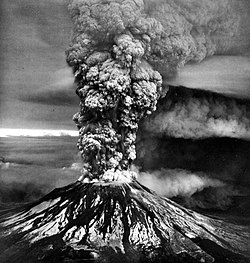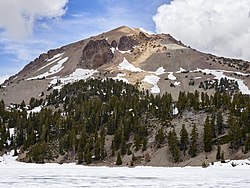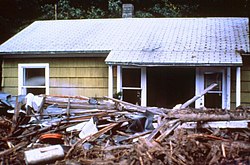
The Mount St. Helens eruption was a major volcanic eruption of Mount St. Helens in Skamania County in the state of Washington in the United States which occurred on the 18th of May 1980. The explosion was the culmination of eight weeks of volcanic activity which began in Mount St. Helens in late March that year. The eruption measured 5 on the volcanic explosivity index. It is considered to be one of, if not the most, disastrous volcanic explosions in the history of the United States. At least 57 people were killed and over one billion dollars’ worth of damage was caused to property and the local economy and environment. The eruption and the volcanic activity which preceded it led to some temporary migration away from Mount St. Helens, but overall it had little lasting demographic impact as the volcano is located in Gifford Pinchot National Forest, a relatively thinly populated part of the United States.[1]
Research your ancestors on MyHeritage
Mount St. Helens eruption chronology of eventsMount St. Helens eruption chronology of events

The continental United States has not been home to many major volcanic eruptions in modern times. This is in contrast to other parts of the world such as Iceland and parts of Southeast Asia which have experienced huge volcanic eruptions in the eighteenth, nineteenth, twentieth and twenty-first centuries. Indeed for 65 years after the eruption of Lassen Peak or Mount Lassen in northern California in 1915 a major volcanic incident of any kind did not occur in the contiguous, continental United States. That would make the eruption of Mount St. Helens in 1980 particularly momentous.[2]
Mount St. Helens is an active volcanic mountain located in the south of Washington State. It is known as Lawetlat’la to the local Native American tribes such as the Cowlitz people. It was named after Alleyne Fitzherbert, first Baron St. Helens, a friend of George Vancouver who led the famous British voyage which charted the West Coast of North America in the first half of the 1790s. The mountain was named by Vancouver in honor of his friend during the expedition. It was active for an extended period of time in the 1840s and 1850s, but had been almost entirely dormant for a century and a quarter thereafter.[3]
The period of dormancy came to an end in March 1980 when volcanic activity was recorded at Mount St. Helens. This began in mid-March as some earthquakes hit the region, triggering the volcano after 123 years of hibernation. Late in the month more severe volcanic shocks and activity began which resulted in explosions and what are known as pyroclastic flows, the movement of gas and volcanic matter. This activity continued on a reasonably stable level over the next seven weeks.[4]
Then, quite suddenly, another minor earthquake on the morning of the 18th of May 1980 triggered an explosion which registered 5 on the volcanic explosivity index (VEI). The resulting explosion created a column of lava, ash and other volcanic rock and debris which erupted upwards some 24 kilometers into the sky, releasing thermal energy that was equivalent to the detonating of 26 megatons of TNT explosive. While the initial triggers and explosion were not as great as some other volcanic explosions such as the Krakatoa explosion of 1883 that registered 6 on the VEI, it nevertheless caused a huge explosion based on the release of pressure as a sector of the volcano top collapsed on the morning of the 18th of May. Eventually, ash and debris from the explosion was deposited over eleven different US states and north into parts of Canada.[5]
Extent of migration pursuant from eruptionExtent of migration pursuant from eruption

There was only limited migration associated with the eruption of Mount St. Helens. The volcano is located in Gifford Pinchot National Forest, a largely forested and preserved region straddling the states of Oregon and Washington, one which is very thinly populated. The nearest large urban center is the city of Portland some 70 kilometers to the southwest. Accordingly, there was no need for a mass removal of people out of the impact area in the summer of 1980 and little migration attendant on it, although ash debris and other impacts of a non-lethal or life-threatening variety were felt hundreds of kilometers away as the sky darkened and ash and debris were carried long distances in the wind. Approximately 200 homes were destroyed or damaged in the immediate area within Gifford Pinchot National Forest.[6]
Demographic impact of the eruptionDemographic impact of the eruption
The immediate demographic impact of the eruption was in the deaths of at least 57 people in the vicinity of Mount St. Helens, although the death toll may be as high as 64, as there were several persons who went missing in the region at the time whose deaths may be associated with the disaster but who were not officially recorded as victims of the disaster. Beyond this the main demographic impact was in the manner in which people had to readjust their life and work patterns within Gifford Pinchot National Forest in the months that followed. The animal life and flora and fauna of the area was devastated by the explosion and the destruction it wrought. In many ways, the delicate natural environment of the region is still only recovering in this regard nearly half a century after the event.[7]
See alsoSee also
Explore more about the Mount St. Helens eruptionExplore more about the Mount St. Helens eruption
- Washington Newspapers, 1855-2009 records collection on MyHeritage
- U.S. Public Records Index records collection on MyHeritage
- Western United States, Marriage Index, 1838-2016 records collection on MyHeritage
- Oregon Newspapers, 1867-2009 records collection on MyHeritage
- Researching Your Washington State Ancestors at Legacy Family Tree Webinars
References
- ↑ https://www.usgs.gov/volcanoes/mount-st.-helens/science/1980-cataclysmic-eruption
- ↑ https://www.kqed.org/science/30444/four-days-in-may-mount-lassen-erupted-100-years-ago
- ↑ https://www.usgs.gov/faqs/what-origin-name-mount-st-helens
- ↑ https://volcano.si.edu/showreport.cfm?doi=10.5479/si.GVP.SEAN198005-321050
- ↑ https://earthsky.org/earth/this-date-in-science-cataclysmic-eruption-at-mount-st-helens/
- ↑ https://www.usgs.gov/volcanoes/mount-st.-helens/science/lahar-hazards-mount-st-helens
- ↑ https://www.livescience.com/6450-mount-st-helens-recovering-30-years.html

